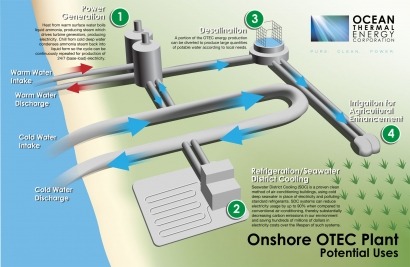
Back in the 1990s,OTE Corporation’s Chief Science Officer, Dr. Stephen Oney, participated at length in the research and development phase of proving a promising renewable energy technology, Ocean Thermal Energy Conversion (OTEC). Dr. Oney’s successful involvement in the Hawaiian pilot OTEC plant launched him into a major role as a premier ocean engineer in the ensuing commercialisation of OTEC. Now, more than 10 years later, Oney and his team are to develop their first commercial system on an island of the Bahamas in the Atlantic Ocean north of Cuba.
According to a report in a Lancaster newspaper, OTE Corporation has signed a memorandum of understanding with Bahamas Electricity Corp., which provides electricity to 85 percent of the country’s electricity consumers, to design and construct two of OTE Corporation’s unique plants. The plants would be owned and operated by OTE Corporation and would cost about $100 million to develop. They would have a nameplate capacity of between five and 10 megawatts.
"We've been working on getting a contract. We always knew it would happen. It was a question of when, not if," Jeremy P. Feakins, OTE chairman and chief executive officer, told the Lancaster’s Tom Mekeel.
The agreement represents a milestone in this novel technology, which comprises “a base-load renewable energy production process particularly suited for tropical zones”. The technology, which OTE Corporation describes as “proven”, having demonstrated the technical viability of a 210 kW pilot plant at the Natural Energy Laboratory of Hawaii, uses the ocean's temperature differential between the warm surface water and the cold deep water to generate both electricity and potable water.
“The 24/7 energy production technology does not depend on fossil fuels, is not vulnerable to world market fluctuations, and has less environmental impact than other energy producers,” explains the company. OTEC power production facilities offer considerable savings for the producer and consumer while establishing energy and resource independence for the communities they serve. Such facilities also establish clearly predictable operating costs and eliminate nearly all adverse environmental impact.
9% of utility’s electricity demand
Most of the power produced at the new facilities on the Bahamas would be used by the local utility to meet 9 percent of its needs, although some would be siphoned off by a desalination plant to provide water and drinking and aquaculture. The potable water would be sold to the Bahamas' water company, explained Feakins, who estimates that each plant will generate over $500 million in revenue for his company over 30 years.
Feakins forecasts that the Bahamas project will be the forerunner of eight power plants to be built by his between now and 2016. "Think of all the tropical countries that can't afford oil to generate electricity and are running out of (potable) water… The potential for this company is huge, both in terms of revenue generation and profit, and the fact that it will change the lives of millions of people worldwide," he said.
Tropical areas are best suited to the technology developed by OTE Corporation as the temperature difference between deep water and surface water is biggest nearer to the equator. Warm surface water is used to heat liquid ammonia to produce steam to drive electricity turbines, while cold deep water is used to condense the ammonia steam back into liquid, beginning the cycle over again. "This is a global game-changer — and we're the company that's bringing it," Feakins told the Lancaster publication.
“At OTE Corporation, we believe that by wise economic use of the proven technology, OTEC, we can and will bring clean energy, fresh drinking water and sustainable fish-farming to millions of people across the globe AND, in doing so, generate significant financial returns for our corporate shareholders,” says the company on its website. “We also believe that the global clean energy and fresh water produced by OTE Corporation will help preserve our environment for future generations to come AND enhance international security for all free nations by greatly reducing the demand for fossil fuels in many regions of the world.”
In addition to this project in the Bahamas, OTE Corporation has also received a Preliminary Power Purchase Agreement to build, own and operate another facility for a pacific island utility. These Atlantic Ocean and Pacific Ocean based projects “signal the start of OTE Corporation’s globalisation of its competitively priced renewable energy resource”.
OTE Corporation has also recently consummated a Term Sheet, under which it will construct the world’s largest deep ocean Seawater District Cooling (SDC) facility, saving an estimated 80-90 percent in air conditioning electricity usage for a world-class luxury resort, the location of which has not been revealed.
For additional information:

